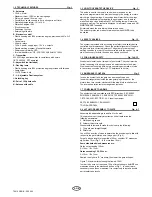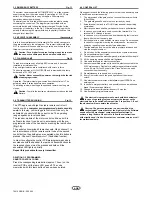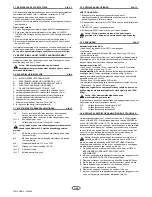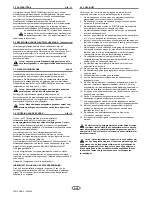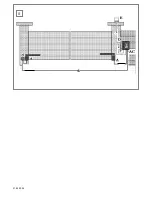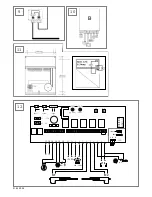
1.2 TECHNICAL FEATURES
Fig. 1
A. Actuators
• 12V d.c. Motor
• Maximum thrust: 150N on the closing edge
• Piston rod speed: 1.5cm per sec.
• Possibility of continuous work (for a short period of time)
• Operating temperature: -15
0
to +45
0
• Protection degree: IP44
• E-lock connection
• Pedestrian function
• External light feature
B. Electronic control
• Plastic housing with IP44 protection degree, provided with No. 3+2
fairleads
• Control card
• 40 amp. relays
• 12V a.c. power supply input; 12 V d.c. outputs
• Double working program: Manual/Automatic
• Power supply warning LED
• Toroidal transformer - CE - 230/120V 50/60Hz 12V 100W
C: Transmitter
433.92MHz quartz transmitter in compliance with norms
I-ETS 300 220, PPT approved.
D: Keyswitch (not included)
E: Flashing lamp
• Plastic housing with IP44 protection degree provided with fairlead
• Lamp holder
• 12V 10W max. bulb
F - L: Adjustable Fixation system
I: Unlocking key
M: Pair of 12V photocells
N: Antenna with cable
1.3 HOW TO OPERATE THE DEVICE
Fig. 2
The pulse is sent to the remote control and is received by the
electronic programmer which provides to supply the energy to motors
which drive the gate wings. A second pulse will provide for the wings
closing. By adequately programming the equipment, one is able to
make the wings close automatically. The Flashing lamp will warn the
wings are moving. The system is designed to last many years and NO
MAINTENANCE is needed.
At intervals wash the actuators with water and soap.
The actuator piston rod made of stainless steel has NEVER to be
lubricated.
1.4 SAFETY ADVISES
Fig. 12
The system is provided with a crushing-proof electronic safety device
controlled by microprocessor. Check the perfect alignment of the gate
hinge pivots for a correct adjustment. The gate mutst be in proper
working condition in order to function correctly with the opener. A gate
stop is necessary for both the open and closed postitions.
1.5 FOR HIGHER SAFETY
Fig. 14 & 15
We advise to install one or two pair of photocells. They shall provide
for the reopening of the wings in case an object obstructs their way.
We also advise to comply with norms concerning automation in force
in the various countries (refer to 1.7 Compliance to norms).
1.6 EMERGENCY CONTROL
Fig. 3
In case the system fails, the gate can be manually opened.
Insert the triangular key inside the triangular plug placed over the
motors, then turn counter-clockwise till the stop. Motors shall unlock.
The inverse operation restores the gate automation.
1.7 COMPLIANCE TO NORMS
The equipment is in compliance with EEC directives: EEC 89/392
EN61000-3-2 EN61000-3-3. EN55014 ETS 300 683 ENV 50141.
1-ETS 300-220 CEPT T/R 01-04. Class II equipment.
EEC 72/23 EN60335/1, EN60529/II.
TÜV GS APPROVAL.
2.0 ACTUATORS ASSEMBLY TO PLATE
Fig. 4-7
Assemble the adjustable plate and fix it to the wall.
This operation is extremely important as it shall determine the
following parameters:
1. Gate opening speed
2. Actuator thrust strength
Fundamental elements to make this choice are the following:
1. The gate size (weight/length)
2. Pillar size
You will find a series of sizes to determine the positioning of plate with
respect to the gate rotation axis (hinge pivot) (Fig. 6).
For gate whose length is longer than 150cm, consider “B” measures
higher than 10cm (Fig. 7 - B is more than 10cm).
Some standard advised measures are:
Gates not exceeding 150cm.
A = 12cm / B = 12cm
Gates exceeding 150 - 200cm
A = 14cm / B = 14cm
Remind the higher is “B” measure, the slower the gate will open.
Figure 7: Maximum thrust strength allowed: 150N
In order to be sure not to exceed 15kg of thrust strength, do NOT use
measures shown in the blackened boxes of Fig. 7. In case it were
necessary to use those measures, it is compulsory to install a double
pair of safety photocells.
2-GB
709145B-GB - 05.2004
Summary of Contents for WGO200
Page 23: ...ca 700mm 1 2 3 4 5 01 05 2004 ...
Page 24: ...maximal 1100mm 6 1100mm max 7 01 05 2004 ...
Page 25: ...3 4 8 01 05 2004 ...
Page 27: ...13 2 1 2 1 Module 433MHz 418MHz 27MHz Logic Board 01 05 2004 ...
Page 28: ...12V 12V NC min 0 5 mm 2 NC C NO 10 11 1 2 10 11 1 2 5m max 14 15 01 05 2004 40 cm ...













